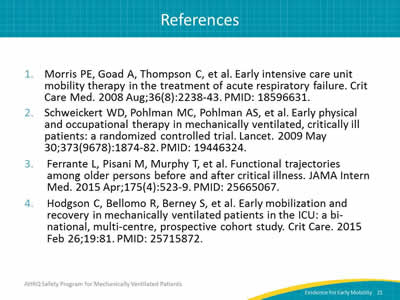Introduction and Evidence for Early Mobility: A Protocol To Get Patients Out of Bed Faster: Facilitator Guide
AHRQ Safety Program for Mechanically Ventilated Patients
Slide 1: Introduction and Evidence for Early Mobility: A Protocol To Get Patients Out of Bed Faster
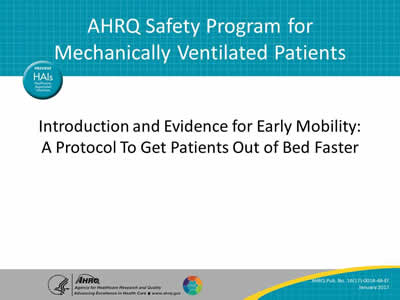
Say:
This module provides an introduction to and the evidence behind early mobility. We will also discuss establishing a protocol for getting the patients out of bed faster.
Slide 2: Learning Objectives
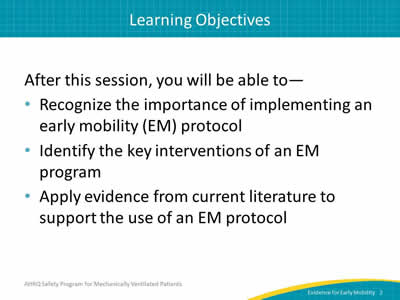
Say:
At the end of this module, you will be able to recognize the importance of an early mobility program, identify the key interventions of an early mobility program, and apply evidence from current literature to support the use of an early mobility protocol.
Slide 3: Importance of Early Mobility
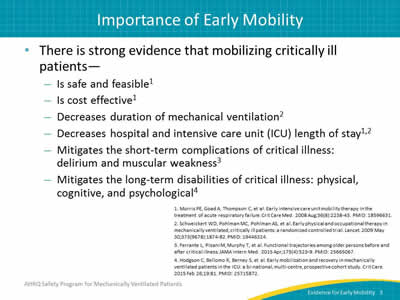
Say:
There is strong evidence that mobilizing critically ill patients is, first and foremost, safe and feasible. There is also a catalog of research showing a correlation between early mobilization and decreases in not only the duration of mechanical ventilation but decreases in both the intensive care unit, or ICU, and hospital lengths of stay as well. Early mobility also mitigates the shorter term complications of mechanical ventilation, including delirium and muscular weakness. And finally, it mitigates the longer term physical, cognitive, and functional disabilities from critical illness, which all have the potential to be measurably debilitating.
Slide 4: Daily EM: Summary of Key Interventions
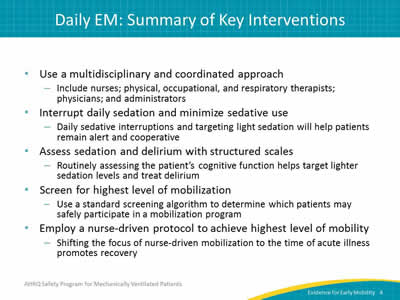
Say:
These are the five key daily early mobility interventions that can be used to improve the mobilization of your mechanically ventilated patients. These interventions begin with using a multidisciplinary and coordinated approach that includes the joint participation of nurses, doctors, physical, occupational, and respiratory therapists, and technicians and administrators to create what the Society of Critical Care Medicine calls, "a culture of mobility." This approach also works to achieve consistent mobility for all of your patients.
The second intervention is interrupting daily sedation and minimizing sedative use. Heavily sedated patients are not able to safely participate in a mobility program, and so targeting light sedation and interrupting sedation daily enable them to remain alert and cooperative.
Using structured assessments of sedation and delirium through validated scales might more effectively target light sedation levels for your patient and mitigate and treat delirium. By doing this, patients can be effectively and reliably mobilized.
The fourth intervention is to screen every day for the highest level of mobility your patients achieve. Implementing a standard algorithm to screen patients can help determine which patients may safely participate in a mobilization program.
And then the final intervention: employing a nurse-driven protocol to achieve the highest level of mobility. As we know, traditionally nurses mobilize patients once they have recovered from their acute illness. However, shifting the focus of nurse-driven mobilization to the phase of acute illness when they’re very sick and integrating a systematic protocol into routine nursing care can promote recovery.
Slide 5: Evidence From Two Studies
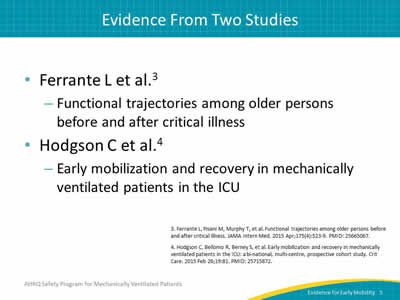
Say:
Two recent studies provide insight into the need for early mobilization. The first, by Ferrante et al. and published in the Journal of the American Medical Association Internal Medicine in 2015, demonstrates a significant decline in the functional trajectories among older people before and after critical illness.
The second, conducted by Hodgson et al. and published in Critical Care in 2015, provides evidence that early mobilization positively impacts the recovery of mechanically ventilated patients in the ICU.
We will now review the evidence from these studies.
Slide 6: Functional Trajectories Among Older Persons Before and After Critical Illness
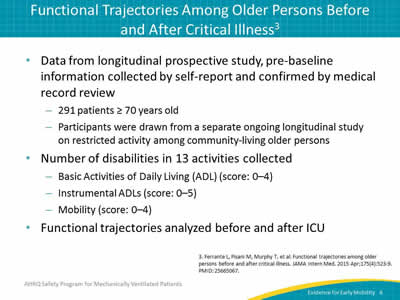
Say:
The functional trajectories among older persons before and after critical illness were examined in a longitudinal, prospective study conducted between 1998 and 2012. It included 291 patients, age 70 or older, who had at least one ICU admission through 2011. Participants were drawn from a separate ongoing longitudinal study on restricted activity among community-living older persons, and data were collected by self-report and corroborated with medical records. The study collected the number of disabilities found in 13 activities as measured through the basic activities of daily living (ADL), instrumental ADLs, and mobility. Their functional trajectories were analyzed before and after their stay in the ICU.
Slide 7: Functional Trajectories Pre and Post ICU
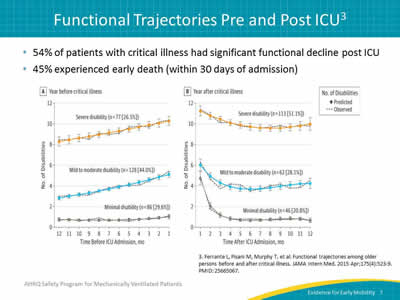
Say:
Results from this study, published in the Journal of the American Medical Association in 2015, illustrate that 54 percent of observed patients who entered the ICU had a significant functional decline following ICU discharge. 45 percent of observed patients experienced an early death, defined as death occurring within 30 days of the admission date.
Slide 8: Functional Trajectories Pre and Post ICU
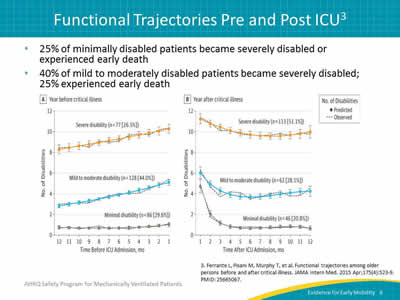
Say:
Twenty-five percent of patients considered minimally disabled upon admission to the ICU became severely disabled or experienced an early death. Forty percent of mild to moderately disabled patients became severely disabled, and 25 percent experienced early death.
Slide 9: Mortality Associated With Worsening Pre-ICU Functional Trajectory
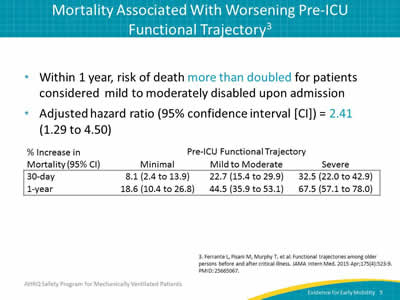
Say:
For those patients considered to be mild to moderately disabled and whose functional trajectory was worsening prior to their ICU admission, the risk of death within 1 year more than doubled.
Slide 10: Mortality Associated With Worsening Pre-ICU Functional Trajectory
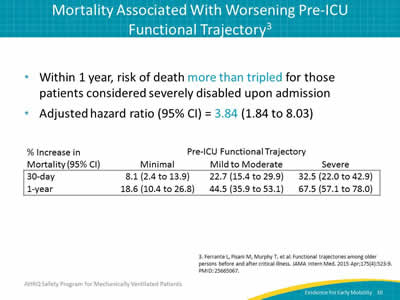
Say:
For those patients considered severely disabled and whose functional trajectory was worsening prior to their ICU admission, the risk of death within 1 year more than tripled.
Slide 11: Summary
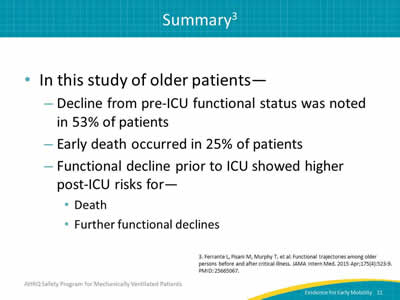
Say:
To recap, in this study of older patients who were analyzed for a year following an ICU admission, 53 percent experienced a functional decline from their pre-ICU status. Twenty-five percent experienced early death. In addition, when a functional decline was already occurring prior to admission, the patient had a higher risk of death and further functional decline following discharge.
Slide 12: Early Mobilization and Recovery of Mechanically Ventilated Patients in the ICU
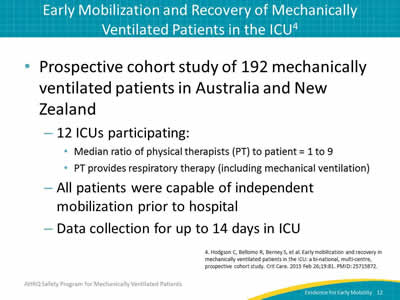
Say:
The relationship between early mobilization and the recovery of mechanically ventilated patients in the ICU was examined in a prospective study of 192 previously mobile, mechanically ventilated patients across Australia and New Zealand. Among the 12 participating ICUs, the median ratio of physical therapists to patients was 1 to 9. All ICUs included respiratory therapy as a component of physical therapy. Data were collected for up to 14 days in the ICU.
Slide 13: Objectives
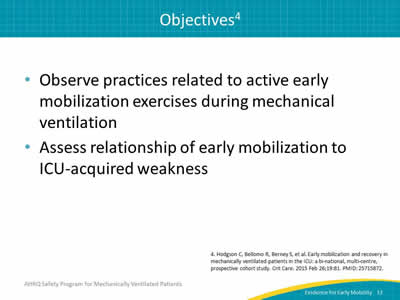
Say:
The objectives of this study were to observe the practices related to active early mobilization exercises of patients on mechanical ventilations, as well as to assess the relationship between early mobilization and ICU-acquired weakness.
Slide 14: Findings
![122 (64%) of patients did not receive any EM. In ventilated patients who received EM: Median (interquartile range [IQR]) time to EM: 5 (3-8) days. Median (IQR) number of EM sessions: 2 (1-4). For 209 PT sessions: 45 percent involved exercises in bed. 25 percent involved passive transfer to sitting. 11 percent involved sitting over the edge of the bed. 11 percent involved standing at the bedside. 4 percent of all sessions involved transfer from bed to chair through standing. 12 percent involved walking (no patients walked before day 7).](/sites/default/files/wysiwyg/professionals/quality-patient-safety/hais/tools/mvp/modules/technical/intro-early-mobility/intro-early-mobility-slide14.jpg)
Say:
One hundred twenty-two out of 192 ventilated patients, or 64 percent, did not receive any early mobilization. Of those ventilated patients who did receive early mobilization, the median time to beginning those activities was 5 days and the median number of sessions received during their time in the ICU was two.
Two hundred and nine physical therapy sessions were observed for patients who were mechanically ventilated in the ICU for at least 2 weeks. As you can see here, in 45 percent of these sessions, patients were able to exercise in bed. 25 percent involved passive transfer to sitting, 11 percent involved sitting over the end of the bed—meaning their legs dangled over the edge—11 percent involved patients standing at the bedside, 4 percent involved having the patient transfer from bed to chair through standing, and in 12 percent of sessions, patients were able to walk. No patients, however, were mobilized to walking before day 7.
Slide 15: PT Reported Barriers to Early Mobilization
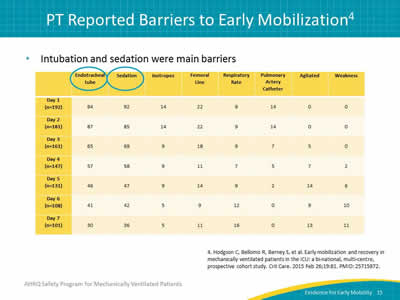
Say:
Physical therapists involved in the care of these patients reported that for the patients who did not receive early mobilization, presence of intubation and sedation were the main barriers to implementing early mobility activities during the first 7 days of mechanical ventilation. Keep in mind that while intubation was found to be one of the main barriers in this study, it is not considered a clinical contraindication for early mobility.
Slide 16: Time to Activity
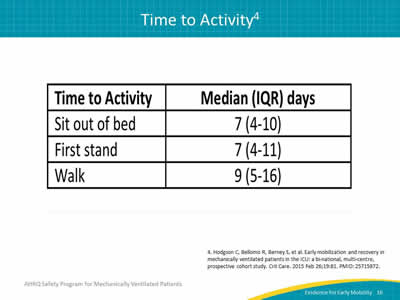
Say:
The median times it took for patients to first sit out of bed and first stand were both 7 days. The median time it took for patients to first walk was 9 days.
Slide 17: Other Outcomes
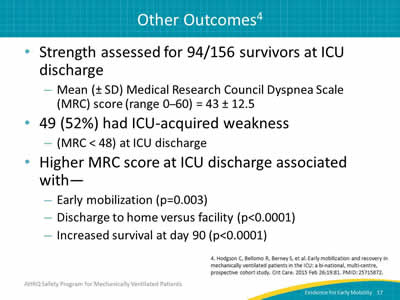
Say:
Other outcomes of the study showed that the mean Medical Research Council Dyspnea Scale or MRC score was 43 (out of a 0–60 range; higher is better). Fifty-two percent of patients experienced ICU-acquired weakness, defined as an MRC score of less than 48. Patients who were mobilized early had higher MRC scores at discharge, were more often discharged to home instead of a care facility, and had increased survival at day 90 post-discharge.
Slide 18: Summary
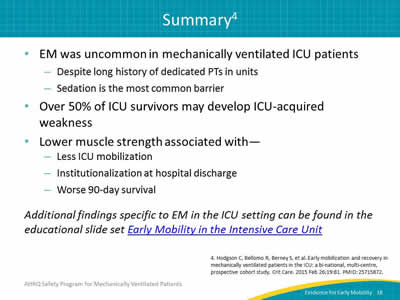
Say:
To summarize the results of this study, we can see that despite a long history of dedicated physical therapists in the units, EM remains uncommon among mechanically ventilated patients with intubation and sedation cited as the most common barriers. More than 50 percent of ICU survivors developed ICU-acquired weakness, associated with less mobilization in the ICU, the need for institutionalization following discharge, and a lessened 90-day survival rate.
Slide 19: Evidence of Early Mobility—Recap
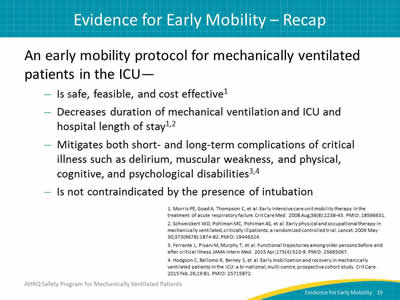
Say:
Now that we’ve reviewed some of the research on implementing an early mobility protocol, we’ve learned several things.
Ask:
What have we learned?
Say:
We now know that implementing an early mobility protocol in the ICU is not only safe, feasible, and effective, but also can decrease the time spent on mechanical ventilation and in the ICU and hospital, and can mitigate both short- and long-term complications from critical illness, such as muscle weakness and cognitive and psychological disabilities. One final thing we should remember is that despite intubation being cited as one of the most common barriers to performing early mobility exercises, intubation is not itself a contraindication to starting an EM protocol.
Slide 20: Questions?

Slide 21: References
